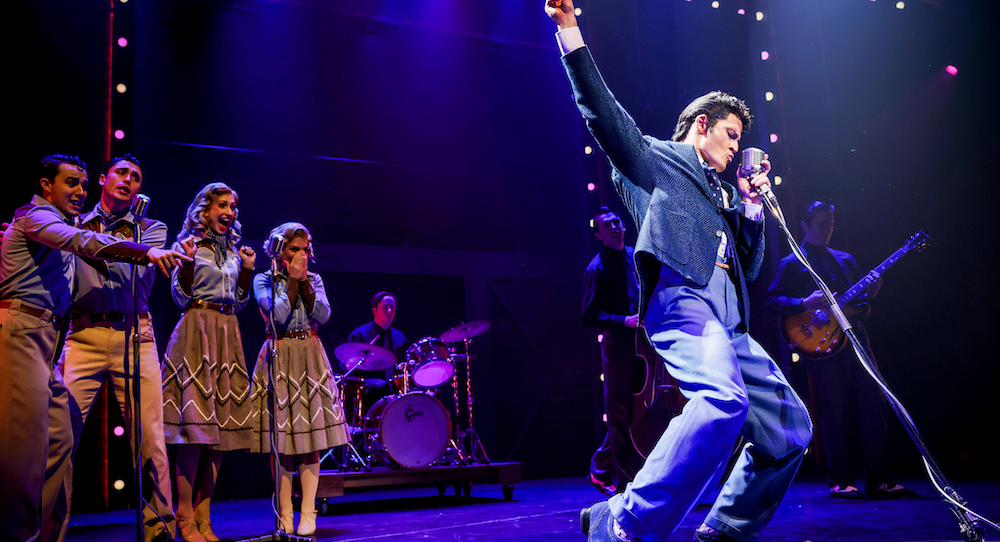Of the many things we know about Elvis, it is the thriving impersonator industry that looms as one of the weirdest and most persistent. Indeed, there is an air of kitsch about the Tupelo born singer that not even Luhrmann glitz can hide. Yet, none of that serves to dampen audience enthusiasm for the hip swivelling king.
Elvis Aaron Presley was emblematic of modern celebrity, especially the youth-oriented kind that emerged as the ‘baby boomer’ generation moved through childhood and adolescence. His arc, from young rebel glamour to vanilla mainstream and bloated, middle aged Vegas parody, is a story typical of so-called stardom. It is this that makes him so attractive to fellow artists. His story is at once remarkable and prosaic; and amidst all the noise, a human being waiting to be found.

For the creators of the Australian devised stage show, Elvis: A Musical Revolution, the challenge has proved surmountable. Since opening last winter, they have toured the country to glowing reviews and punter pleasure. Now, a year on, they are ready to return to Melbourne for an encore season. (Back by popular demand, etc.)
Having already won a Green Room Award for his original choreography, Michael Ralph is currently travelling with the production as resident director. As one of the key creatives, he knows firsthand the trickiness of working with a character so beloved, and around whom so much expectation lingers.
Speaking to Dance Informa from the Gold Coast (where the show is on its sixth run since it premiered in Sydney in 2023), he unpacks the finer details. “It’s always a challenge to create anything that’s tampering with such a well known person or show or product,” he begins. “I’ve done quite a few shows that have been biographical musicals, so, for me, I start off trying to gain as much understanding as possible. I try to watch as much footage as I can on YouTube, and read as many books as I can get hold of. Then I go into a room and start to look at what’s actually on the page, the music and the script for a production, and then try and see what we’re actually trying to say in our version. What tone are we trying to take?”

As a choreographer, however, Ralph’s task was to graft new routines onto a figure and an era with a well defined dance language, and all without lapsing into mere impersonation. As he recalls, “My offering to the piece was to find ways to use choreography to help tell the story, within what was obviously a jukebox musical.”
When working with the show’s lead (former Home and Away star Rob Mallett), Ralph needed to take particular care. “The thing about Elvis was that the way he moved was so natural. He didn’t really do choreography. He moved in the way he felt. It was very much an organic way of reacting to the music, and it kind of came out of him because of his upbringing, and the black community he grew up around in the church, where he learned about music and how to move with a sense of soul.”
The same is true for the rest of the cast. Elvis: A Musical Revolution traces The King’s career from his breakout days in the ’50s to his now famed 1968 ‘comeback’ special and, as such, it recreates many of the popular social dances of that time.
Here again, a mix of nostalgia and orthodoxy play into audience expectation. As Ralph says, “People have set ideas about how they should move in the ’50s and ’60s, and I guess I tried to absorb as much of that vocab as I could so that people would find it authentic, but then find a way to arrange that vocab in a way that would make the audience feel something other than nostalgic.”
Taking improvised routines from milk bars and dance halls and putting them on the mainstage is another level of challenge. Choreographically, Ralph and the cast are trying to find a balance between naturalism and good technique. Although the 2024 music theatre version adds a coat of exactness, it remains careful to keep faith with the originals.

“What they did have in the ’40s, ’50s, ’60s was a lot of feel and rhythm,” Ralph notes. “They’re moving without having too much ‘judgement’ about what they’re doing…and I then use that to inspire what I put on stage, except maybe make it a little more impressive.”
As someone who now has an astonishing five Green Room Awards to his name, and whose CV spans Cats to Legally Blonde to So You Think You Can Dance, Ralph is used to both creative expectation and the need for freshness. Of his role with Elvis: A Musical Revolution, he observes, “It feels like you’re giving the performers a roadmap, or some shapes or iconic moves that people might expect, but essentially the artist has to inhabit that themselves. They have to make it their own and move within that blueprint as though it was organic and not overly set; even though it is thoroughly set.”
This is likely true of all dance performance, yet with Elvis, and the iconography that surrounds both him and the era, it is magnified. However, as industry awards, five star reviews and sell out seasons indicate, Michael Ralph, Rob Mallett and crew have found the right blend; and perhaps given us something more nuanced than rock & roll rehash.
Elvis: A Musical Revolution is running at Melbourne’s Athenaeum Theatre from 27 July – 11 August. For tickets, click here.
By Paul Ransom of Dance Informa.















